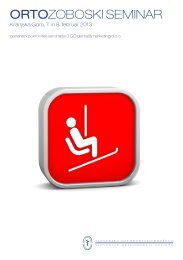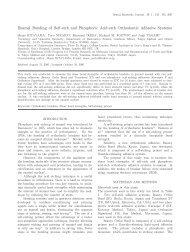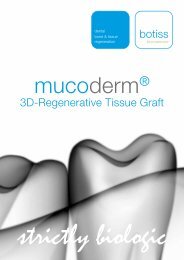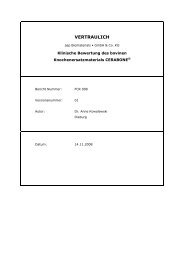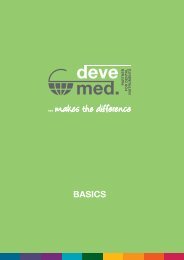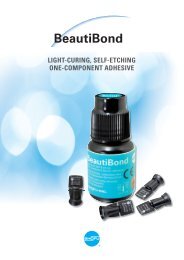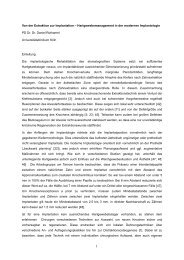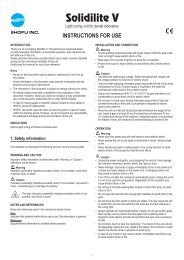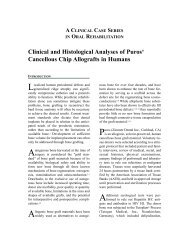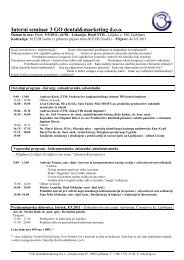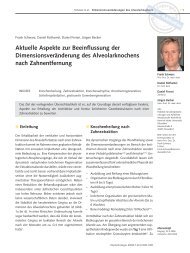Duraplasty: Our Current Experience - 3 go / dental&marketing
Duraplasty: Our Current Experience - 3 go / dental&marketing
Duraplasty: Our Current Experience - 3 go / dental&marketing
You also want an ePaper? Increase the reach of your titles
YUMPU automatically turns print PDFs into web optimized ePapers that Google loves.
<strong>Duraplasty</strong> Surg Neurol<br />
2004;61:55–9<br />
ever possible, but when it is not possible, we prefer<br />
to use homolo<strong>go</strong>us implants.<br />
Despite the theoretical advantages of no risk of<br />
infection of the synthetic materials [2], most of these<br />
have been rejected because of local tissue reactions,<br />
excessive scar formation, meningitic symptoms, or<br />
hemorrhage risk [1,2,13,19,31,33,34,35,41,50].<br />
For many years lyophilized homolo<strong>go</strong>us dura mater<br />
sterilized by � rays (Lyodura) has been widely<br />
used because it is easy to handle and widely available<br />
[9,10,24,39,50]. Unfortunately, the current sterilization<br />
methods do not guarantee them free from<br />
risk of latent virus infections [16,42,49], and some<br />
cases of probable Creutzfeldt-Jacob disease (CJD)<br />
after homolo<strong>go</strong>us dura mater implant have been<br />
reported [42]. However, these cases remain circumstantial<br />
because there are not other cases in patients<br />
treated with the same lot of dura. Moreover,<br />
the use of cadaveric dural grafts has not been prohibited<br />
by World Health Organization [50].<br />
In our institution we have used Tutoplast dura as<br />
dural substitution for many years because it is a<br />
material widely available, waterproof, with tensile<br />
strength, easily suturable, biocompatible, and relatively<br />
inexpensive.<br />
Despite achieving <strong>go</strong>od results in our patients<br />
with Tutoplast Dura implant (no complication in<br />
more than 99% of the cases), we think that the risk<br />
of transmission of prionic disease, even if minimal<br />
and never proven, should proscribe its use. Until<br />
now, iatrogenic transmission of CJD occurred by<br />
corneal implantation, intracranial electrodes, human<br />
growth hormone extracts from cadaveric pituitary<br />
gland, and cadaveric dura mater graft [42]. In<br />
experimental transmission, the CJD agent has been<br />
found in brain, spinal cord, lung, liver, and kidney<br />
[7,27,42]. In the last several years in our institute we<br />
use Tutoplast pericardium that is a homolo<strong>go</strong>us<br />
material with the same advantages of the Tutoplast<br />
dura but likely safer than homolo<strong>go</strong>us dura mater.<br />
In our series, we found postoperative complications<br />
in 4 (1.7%) of the 250 patients subjected to<br />
implant of dural homolo<strong>go</strong>us substitutes. However,<br />
the relationship between dural patch and the complications<br />
in these four cases remains debatable.<br />
In patients No. 1 and No. 2 a postoperative meningeal<br />
syndrome was documented by clinical picture<br />
and laboratory test.<br />
In patient No. 1 meningeal reaction was aseptic,<br />
and the operation was performed in posterior cranial<br />
fossa. In this case we can hypothesize either an<br />
inflammatory reaction of the host against the implanted<br />
material or a spread of blood breakdown<br />
products into subarachnoidal spaces, causing an<br />
irritative meningeal syndrome. The latter hypothe-<br />
57<br />
sis is sustained by the fact that aseptic meningitis<br />
syndrome has been described as a common complication<br />
of posterior cranial fossa surgery<br />
[12,15,17].<br />
In the remaining patients there was an infection,<br />
and in those cases it can be hypothesized as both<br />
an infection arising from dural plasty and a contamination<br />
unrelated to the dural graft.<br />
The latter hypothesis is supported by the fact<br />
that the method of preparation of Tutoplast and<br />
�-irradiation ensures the sterility of the grafts [10]<br />
and because there were no other cases of infection<br />
in patients of our series treated with the same lot of<br />
dura.<br />
In patient No. 2 it could be reasonably assumed<br />
that the development of infection was because of a<br />
contamination from extracranial bacteria. This is<br />
supported by the presence of a connection between<br />
the endocranium and the airways.<br />
In patients No. 3 and No. 4 we found at the previous<br />
surgical wound an SC and submuscular purulent<br />
collection positive for St. Aureus and St. Epidemidis,<br />
respectively.<br />
At reintervention, Patient No. 3 presented SC and<br />
submuscular purulent collection, disappearance of<br />
the dural patch, and no signs of infection on the<br />
cerebellar surface. From these aspects we can presume<br />
that the infection started in the superficial<br />
tissues and destroyed the dural patch.<br />
In Patient No. 4 there was an extradural purulent<br />
collection, complete dural patch resorption, and<br />
signs of inflammatory reaction on cerebellar surface.<br />
Also, in this case we can suppose that infection<br />
is originated extradurally because the cultures<br />
of the purulent SC and submuscular collection were<br />
positive for an infective agent commonly present in<br />
the skin and easily destroyed by �-sterilization.<br />
Keener [21] stated that only fibroblast originating<br />
from soft tissues (muscle, fascia, SC space) regenerate<br />
the dura, and when dural defect is adjacent to<br />
bone, dural healing is inadequate.<br />
In our cases No. 3 and No. 4 dural patch was<br />
adjacent to soft tissue, but it is likely that the septic<br />
contamination and consequent inflammatory reaction<br />
destroyed the dural graft more rapidly than the<br />
time needed for fibrous infiltration and dural regeneration<br />
processes.<br />
Adherence to the cortex were not observed in the<br />
4 patients who underwent an early reoperation or in<br />
the 9 patients reoperated on tardily. Macroscopically,<br />
dural patch was preserved and appeared as<br />
host dura. In 1 patient there was granulation tissue<br />
above the graft when this was exposed in a small<br />
area without bone. In 3 patients who had post-



